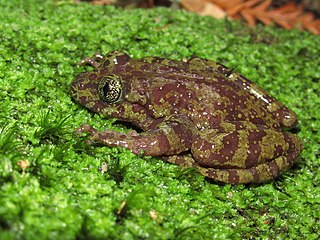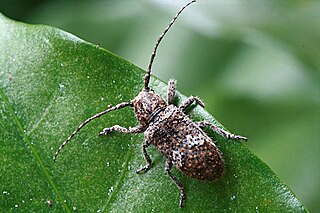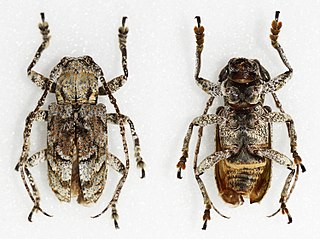
Hiodontiformes is an order of ray-finned fish consisting of the two living species of the mooneye family, Hiodontidae, and three extinct genera.

Sabal is a genus of palms endemic to the New World. Currently, there are 17 recognized species of Sabal, including one hybrid species. The species are native to the subtropical and tropical regions of the Americas, from the Gulf Coast/South Atlantic states in the Southeastern United States, south through the Caribbean, Mexico, and Central America to Colombia and Venezuela. Members of this genus are typically identified by the leaves which originate from a bare, unarmed petiole in a fan-like structure. All members of this genus have a costa that extends into the leaf blade. This midrib can vary in length; and it is due to this variation that leaf blades of certain species of Sabal are strongly curved or strongly costapalmate or weakly curved, weakly costapalmate,. Like many other palms, the fruit of Sabal are drupe, that typically change from green to black when mature.

Peter Rosei is an Austrian literary writer.

Heleophrynidae is a family of frogs, commonly known as ghost frogs. They are thought to be the most basal group in the Neobatrachia. The family consists of two genera, Heleophryne and Hadromophryne, with seven species. Ghost frogs live in swift-moving mountain streams in South Africa. The common name of "ghost frogs" may have been coined because of their occurrence in Skeleton Gorge.

The Cape mountain toad or Rose's mountain toad is a species of toad in the family Bufonidae. Other common names include Rose's mountain toadlet, striped mountain toad, Rose's toad, and Muizenberg Cape toad. It is endemic to South Africa, where its natural habitat is Mediterranean-type shrubby vegetation known as fynbos. It is threatened by habitat loss.

Rose's rain frog or Rose's rainfrog is a species of frog in the family Brevicipitidae. It is endemic to the sandveld of south-western coastal South Africa. It is less-frequently known as Rose's short-headed frog, Rose's Blaasop, or the sand rain frog. Some treat Breviceps fasciatus as a synonym of this species, although other authorities have expressed doubt.

Rose's ghost frog, or Table Mountain ghost frog, is a species of frog in the family Heleophrynidae endemic to South Africa. It is a medium-sized species with purple or brown blotches on a pale green background and large discs on its fingers and toes. It has a very restricted range, being only known from the slopes of parts of Table Mountain. The tadpoles live in permanent streams but these are in danger of drying up because of the establishment of pine plantations. Because of its small range and changes in its habitat, this frog is listed as critically endangered by the International Union for Conservation of Nature.
Minuartia rosei is an uncommon species of flowering plant in the family Caryophyllaceae known by the common names peanut sandwort and peanut stitchwort.
Franz Rosei is an Austrian sculptor and draughtsman. His brother is the writer Peter Rosei.
Alaena rosei is a butterfly in the family Lycaenidae. It is found in Angola, where it is only known from the area near Gabela and the vicinity of Lubango.

Miletus rosei is a butterfly in the family Lycaenidae. It is found in northern Sulawesi.
Mabrya rosei is a mat-forming herbaceous perennial native to the Mexican states of Jalisco and Zacatecas. It has tubular flowers, whitish at the base and red to red-violet at the apex. It was first described by Philip A. Munz in 1926 in the genus Maurandya and transferred to Mabrya by Wayne J. Elisens in 1985. Munz did not explain the origin of the epithet rosei but listed the collector of the type specimen as Joseph Nelson Rose.

Rhytiphora is a genus of flat-faced longhorn beetles in the Pteropliini tribe of the subfamily Lamiinae. The genus was first described in 1835 by Jean Guillaume Audinet-Serville.

Rhytiphora bankii is a species of beetle in the family Cerambycidae. It was first described by Johan Christian Fabricius in 1775, under the genus Lamia. It is known from Australia, the Philippines, Borneo, Java, Micronesia, New Guinea, Hawaii, Moluccas, Sumatra, Vietnam, and has been introduced into Japan. The Australian species of Prosoplus were synonymised with Rhytiphora in 2013.

Rhytiphora maculicornis is a species of beetle in the family Cerambycidae. It was described by Francis Polkinghorne Pascoe in 1858. It is from Australia.
Rhytiphora saundersi is a species of beetle in the family Cerambycidae. It was described by Francis Polkinghorne Pascoe in 1857. It is known from Australia. It contains the varietas Rhytiphora saundersi var. spenceri.
Rhytiphora sospitalis is a species of beetle in the family Cerambycidae. It was described by Francis Polkinghorne Pascoe in 1865. It is known from Australia.
Rhytiphora albocincta is a species of beetle in the family Cerambycidae. It was described by Félix Édouard Guérin-Méneville in 1831, originally under the genus Saperda. It is known from Australia. It feeds on Acacia pubescens and Acacia longifolia. It contains the variety Rhytiphora albocincta var. compos.
Asarum rosei is a species of flowering plant endemic to North Carolina in the southeastern United States. It was first formally described in 2017 by Brandon T. Sinn in Phytotaxa. The species is named for Mark Rose, "a respected plant collector, horticulturalist, orchid breeder, and naturalist who discovered and documented the species".










